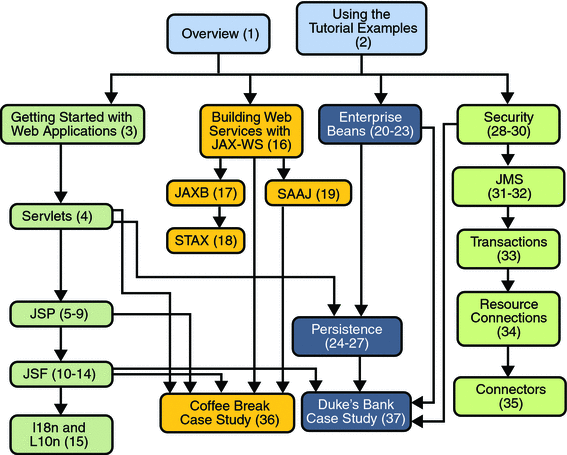How This Book Is Organized
The Java EE 5 platform is quite large, and this tutorial reflects this. However, you don’t have to digest everything in it at once. The tutorial has been divided into parts to help you navigate the content more easily.
This tutorial opens with an introductory chapter, which you should read before proceeding to any specific technology area. Chapter 1, Overview covers the Java EE 5 platform architecture and APIs, the Sun Java System Application Server 9.1, and how to use the this tutorial's examples.
When you have digested the basics, you can delve into one or more of the five main technology areas listed next. Because there are dependencies between some of the chapters, Figure P–1 contains a roadmap for navigating through the tutorial.
-
The web-tier technology chapters in Part II, The Web Tier cover the components used in developing the presentation layer of a Java EE 5 or stand-alone web application:
-
Java Servlet
-
JavaServer PagesTM (JSPTM)
-
JavaServer Pages Standard Tag Library (JSTL)
-
JavaServerTM Faces
-
Web application internationalization and localization
-
-
The web services technology chapters in Part III, Web Services cover the APIs used in developing standard web services:
-
The Java API for XML-based Web Services (JAX-WS)
-
The Java API for XML Binding (JAXB)
-
The Streaming API for XML (StAX)
-
The SOAP with Attachments API for JavaTM (SAAJ)
-
-
The Enterprise JavaBeansTM (EJBTM) technology chapters in Part IV, Enterprise Beans cover the components used in developing the business logic of a Java EE 5 application:
-
Session beans
-
Message-driven beans
-
-
The persistence technology chapters in Part V, Persistence cover the Java Persistence API, which is used for accessing databases from Java EE applications:
-
Introduction to the Java Persistence API
-
Persistence in the Web Tier
-
Persistence in the EJB Tier
-
The Java Persistence Query Language
-
-
The platform services chapters in Part VI, Services cover the system services used by all the Java EE 5 component technologies:
-
Security
-
Java Message Service
-
Transactions
-
Resource connections
-
The Java EE Connector Architecture
-
Figure P–1 Roadmap to This Tutorial

After you have become familiar with some of the technology areas, you are ready to tackle the case studies in Part VII, Case Studies, which tie together several of the technologies discussed in the tutorial. The Coffee Break Application describes an application that uses the web application and web services APIs. The Duke’s Bank Application describes an application that employs web application technologies, enterprise beans, and the Java Persistence API.
Finally, Part VIII, Appendixes contains information about Java encoding schemes and Java EE certification that may be helpful to the Java EE 5 application developer, and information about the tutorial's authors.
- © 2010, Oracle Corporation and/or its affiliates
